| |
|

LETTER FROM JERUSALEM
Mideast theme song: Send in the clowns?
By Ira Sharkansky
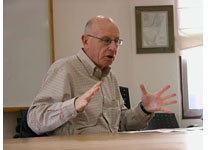 JERUSALEM—Remember Yassir Arafat? JERUSALEM—Remember Yassir Arafat?
Until he was confined to a heavily damaged headquarters by the Israeli army, he traveled the world. He consulted with the Saudi king, with the princes of the Gulf Emirates, with Saddam Hussein and other Arab presidents, with European heads of state, and whoever was supposed to be in charge of the United Nations. News about those meetings dealt with one or another option the Palestinian leader was exploring at the time, and his pursuit of financial aid.
In the final analysis those trips did not seem to help the Palestinians or Arafat. When he died, his successors had to clean a few square meters of rubble from the courtyard of his headquarters in order to bury him.
Guess what Mahmoud Abbas is doing?
Currently he is traveling to Saudi Arabia and Egypt, talking about the prospects of making peace with Israel, and making peace between his party, Fatah, and with the people of Hamas who are in control of Gaza. Yemen has its own active civil war, but it has put on the table a scheme for bringing peace between Hamas and Fatah. Another proposal is for the two parties to sit together under the auspices of the Arab League, and sort out their difficulties there.
Abbas also talks to Condoleezza Rice when she visits the region, and enjoys invitations to consult with George W. Bush in the White House. In this respect, he still has more respect than Yassir Arafat in his final days.
Meanwhile, the Palestine National Authority is saying that it cannot pay its bureaucrats this month. It is Israel's fault, insofar as Israel has not transferred the moneys it collects as import duties on goods destined for Palestine. Surely this is one of the items on Abbas' agenda when he meets with the heads of all those governments, and talks with others on the telephone.
Israel's position about this flap is that as long as the Palestinian prime minister lobbies against Israel's admission to the international economic group, OECD, his government may have to do without the money expected from Israel.
I have a feeling that I am living alongside a circus, being managed by its clowns.
Israel is not a paragon of virtue or good management. The prime minister has been living for years with occasional visits from the police concerned about his financial dealings. The case currently in the headlines may be the most serious yet, and is troubling the attorney general who has to decide on the next steps toward a possible indictment.
The same attorney general has not finished with the convoluted allegations against the former president, including sexual harassment and rape.
But in contrast to the Palestinians, we have a functioning administration that collects taxes, and allocates funds to competent people who operate the public services. Israel's health and higher education programs are arguably better than those which serve the average American. Palestinians have not much of either, or anything else.
Israel has an army that can do a lot of damage in Gaza, the West Bank and elsewhere, but waits on the government to give it orders. Its soldiers are trained to avoid civilian casualties. When Hamas sent thousands of people toward the border with Israel, the officers of the Israeli army had to prepare their troops so that on this occasion they might have to fire on civilians.
Rather than street trials and instant executions, or prisons with open doors that we hear about in Palestine, the attorney general, police, and courts of Israel are professional, and dealing with the detritus in our public sector. A former finance minister has been indicted and is waiting for the onset of his trial. A former health minister has been found guilty, sentenced, and is waiting for the court to hear his appeal.
We are not perfect, but we are not clowns.
I will leave it to my American friends to comment on their political leaders, and the people they are dealing with who are in nominal charge of Afghanistan and Iraq.


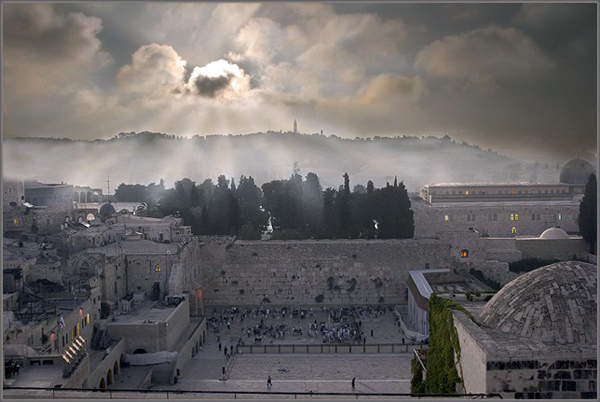
JERUSALEM DIARIES
It's SRO for Shavuot in old Jerusalem
By Judy Lash Balint
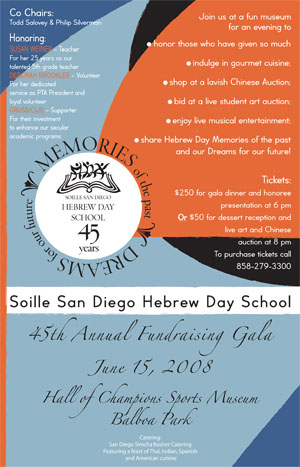
 JERUSALEM—It’s 5:00 a.m on Shavuot morning and I’m having trouble finding an empty seat at any shul in Jerusalem’s Old City. Every synagogue is already packed as I make the mistake of lingering a few minutes too long at the Kotel amongst the tens of thousands who have made their way there after a night of learning. JERUSALEM—It’s 5:00 a.m on Shavuot morning and I’m having trouble finding an empty seat at any shul in Jerusalem’s Old City. Every synagogue is already packed as I make the mistake of lingering a few minutes too long at the Kotel amongst the tens of thousands who have made their way there after a night of learning.
After dropping in at three shuls, I finally find a spot on a bench under an outer archway of the women’s section of the tiny synagogue inside the Old Yishuv Court Museum on Or Hahayim Street. After Hallel and the reading of the Ten Commandments, a swift Haftarah reading brings us to the Yizkor memorial prayer. Only a few women are left inside as the young girls who filled the place and have not yet lost parents file out. It’s about the same proportion down at the Kotel—it seems that at least two thirds of the masses thronging the Kotel plaza are under 30.
Coming barely a week after Jerusalem Day, when similar numbers of mostly young people filled the area to celebrate the reunification of the city, the Shavuot early morning spectacle is another affirmation of the strength of the connection of the people to its roots.
In the still air of the pre-dawn, it’s as if the Old City is a giant magnet pulling the multitudes in from every direction. Flooding down Agron Street in front of the U.S Consulate building and its sleepy guards, the crowd gathers force and takes over the Mamilla area. The Tower of David and Jaffa Gate rise in front of us, outlined by spotlights.
It’s 4:45 a.m as we surge forward and down the steps of the David Street shuk only to encounter a human traffic jam as we make the turn from the Street of the Chain into the approach to the Kotel. A few groups of Arabs heading to work are walking up in the opposite direction. No one bothers them as they make their way out of the Old City through Jaffa Gate.
There are only four entryways into the Kotel plaza and they’re all completely overwhelmed by the numbers of people pressing to get in. With a few friends, I veer off to the left to double around and join the crowd coming in from the direction of Damascus Gate via the tunnel. We manage to squeeze our way into the back of the plaza and start to move toward the women’s section, passing a group of nuns from Holland earnestly reading from their Bibles by flashlight. There’s barely room to move as more and more people surge in from each of the four entry points.
The bright green lights adorning the two mosques behind the Temple Mount shine in the semi-darkness. As the sky begins to change color and turn slowly from a steely grey to light blue, the garish lights vanish. Exactly at sunrise, chattering starlings swoop down, and the voices of the throng rise in prayer.
On this holiday of Shavuot that commemorates the giving of the Torah, the symbolic wedding between God and the Jewish people, most of the women are wearing white and the centuries-old Kabbalistic custom of Tikkun Leil Shavuot, a night dedicated to Torah study is observed by hundreds of thousands of Israelis. On the eve of the holiday, commentators on Israel Radio remark on the phenomenon of secular Jews eager to take part in some kind of Torah learning on Shavuot. One daily paper has a tightly packed full page of venues where learning of all kinds is taking place all over the city. Many places are forced to turn people away for lack of space at their study sessions.
Last year, a May 18 2007 editorial in the American Jewish weekly newspaper, The Forward, noted, “…the proportion of Jews that turns out for the festival (Shavuot) will not be great…Shavuot simply hasn’t caught on with recent generations of Jews.” Perhaps things have changed this year, otherwise Shavuot could be another sign of the widening gap between Israel and the Diaspora.


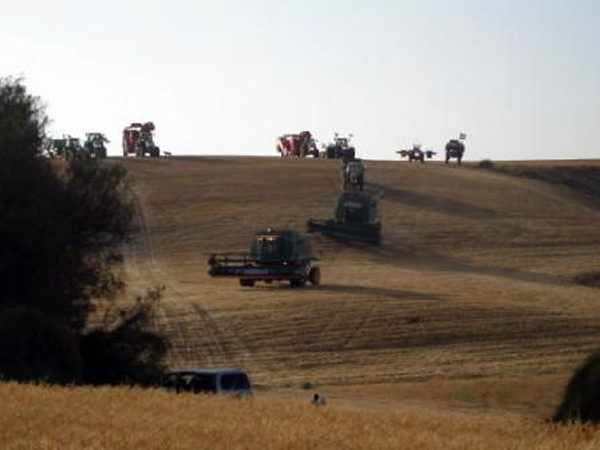
FROM THE GATES OF THE NEGEV
How kibbutz celebrates agricultural holiday
By Ulla Hadar
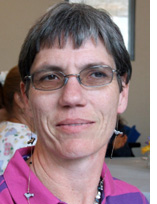 KIBBUTZ RUHAMA. Israel—When I open the door on the northern side of my house the view that strikes my eyes is always breathtaking. No matter what time of the year, the fields are beautiful to look at, and the changing of the seasons always makes the view different. It is a gift to be able to watch the deer running in the faraway fields and hawks and jackals scavenging along the river valleys as numerous bird species fly low in the air. KIBBUTZ RUHAMA. Israel—When I open the door on the northern side of my house the view that strikes my eyes is always breathtaking. No matter what time of the year, the fields are beautiful to look at, and the changing of the seasons always makes the view different. It is a gift to be able to watch the deer running in the faraway fields and hawks and jackals scavenging along the river valleys as numerous bird species fly low in the air.
The inhabitants of Kibbutz Ruhama are blessed with vast fields embracing them at every angle. As a kibbutz member I may feel the relationship to earth more intensely than a city person does. I follow the agricultural process throughout the year and for me the feast of Shavuot is the holiday that I enjoy the most and feel attached to.
In 1944, when the first settlers arrived at Kibbutz Ruhama, situated closed to the desert, the importance of developing agriculture was very clear to them. It was an essential task in the building of a homeland for the Jewish people. From then until now our kibbutz has earned its living mostly by agriculture.
Ruhama's fields cover 20.000 dunam, which is somewhat less than 5,000 acres. (1 acre = 4.047 dunam) Of these, approximately 8.000 dunam are regularly irrigated for the growing of potatoes, sunflowers, onions, carrots, sweet potatoes, chickpeas for hummus and more. On the non-irrigated fields the main crop is wheat.
Both the amount of rainwater and its timing are crucial to the outcome of the crops. This year there was a drought and as a result, the kibbutz suffered financial losses.
Shavuot occurs on the sixth day of Sivan, typically falling in late May or early June. It marks the conclusion of the counting of the Omer and the day the Torah was given to the Jewish people at Mount Sinai. It is one of the shalosh regalim, the three Biblical pilgrimage festivals.
Shavuot has several names: Festival of Weeks, Hebrew: חג השבועות , Hag ha-Shavuot; Festival of Reaping Hebrew: חג הקציר , Hag ha-Katsir; and Day of the First Fruits, Hebrew יום הבכורים , Yom ha-Bikkurim.
In Israel, Shavuot is typically celebrated for one day, whereas In the Jewish Diaspora, and in Israel, among Reform and Karaite Jews, the holiday is celebrated for two days.
The seven species are the agricultural theme of Shavuot. The products symbolize the fertility of Israel. The seven species are wheat, barley, grapevines, figs, pomegranates, olives and honey (from dates).
Wheat in Hebrew chitah. Wheat flour has been the source of our challah dough for over 2,000 years.
Barley is se'orah and is the first grain to ripen in Israel. Because of this, barley marks the start of the spring harvest season and the counting of the Omer (a measure of barley), connecting the holiday of Passover to the holiday of Shavuot.
Grape - anav in Hebrew— and the first cultivated plant mentioned in the Bible (Noah grew them). Grapevines are also a source of pure water (when cut open) and make an excellent building material for shelters. No doubt our ancient ancestors used the vines in the building of their Sukkot.
The fig - te'enah— is mentioned in the Torah in the early chapters of Genesis when Adam and Eve covered their nakedness with fig leaves. In ancient Israel, fig trees were planted in gardens throughout the country.
Pomegranate – rimmon— is one of the seven species the spies brought back with them to show how fertile the land was. According to Midrash, there are exactly 613 seeds in a pomegranate, corresponding with the 613 mitzvot found in the Torah. Pomegranates are frequently pictured in Jewish art works as well as the design for the decorative tops places of the two Torah rollers.
An olive - zayit —is one of the oldest and most valued trees in the Middle East. Olive oil was the fuel source for the great menorah lit in the Temple and played an important role in the diet of our ancient Israeli ancestors. Olive trees can live to be over 1,000 years old and still produce fruit. What many people might not know is that black and green olives are harvested from the same tree. They do not come from different species of olive trees.
To this day in the State of Israel, olive trees are so valued that it is against the law to cut them down if they are still living.
Honey is called d'vash in Hebrew. Israel is called the "land that flows with milk and honey." The type of honey meant here is date honey, not bee honey. Israel has never had enough of a bee population to make it possible to produce bee honey in any large quantities. Date honey was made by placing dates in a pot of boiling water and scooping the fruit sugar off when bubbling to the surface.
In the Kibbutzim, a ceremony is carried out symbolizing the bikkurim.
This year sadly many of the kibbutzim in Sha'ar Hanegev have cancelled their ceremonies because of the continuous rocket attacks from Gaza. Fifty families from Kibbutz Kfar Aza spent the holiday in the Northern Kibbutz Degania Aleph.
Some neighboring kibbutzim— Dorot, Bror Hayil, Ruhama and Or Haner —have invited the kibbutzim in the area to join in their Shavuot ceremonies.
The ceremony in Kibbutz Ruhama started with a big parade of all the farm machines; this year the entrance was from the northern fields.
Like a scene in the Wild West, the machines came driving down the hillsides .
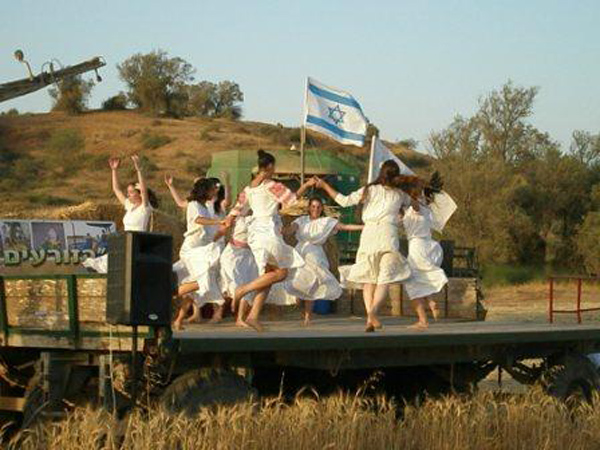

After short speeches and the presentation of the bikkurim on stage, the ceremony continued with dancing and singing.
A special effect was when one airplane from the Chim Nir company flew over the crowd. The airplanes are used in the process of spraying the fields.
It is a custom to bring all the babies born in the same year to the stage together with their mothers and/or fathers. Our kibbutz "crop" this year was four babies.
Ori Levi, head of the agriculture department in Kibbutz Ruhama, plans and conducts the ceremony, together with his devoted team of agricultural workers. They take pride in showing the result of a year’s work and also to be able to demonstrate what the machines can do.
We hope for a better agricultural year next season and look forward to a lot of rain which will lead to healthy growing fields.

THE POLITICAL GROTTO
Block’s win and long-range Nunez plans
By Gary Rotto
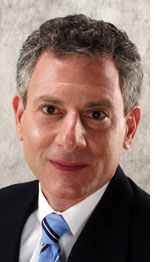 SAN DIEGO—Grass roots versus grass tops. That is the best way to describe Marty Block’s thrilling victory on primary night in the Democratic Primary for the 78th Assembly District. The race did not go as the Sacramento insiders, particularly former Assembly Speaker Fabian Nunez, had anticipated. SAN DIEGO—Grass roots versus grass tops. That is the best way to describe Marty Block’s thrilling victory on primary night in the Democratic Primary for the 78th Assembly District. The race did not go as the Sacramento insiders, particularly former Assembly Speaker Fabian Nunez, had anticipated.
Auday Arabo began and ended as the candidate of Sacramento. He had the insider connections through a relative: former State Senator Wadie Deddeh. And with the support of then-Speaker Fabian Nunez and his chief lieutenant Kevin DeLeon, he amassed an impressive endorsement list of no less than 12 sitting members of the State Assembly. Arabo is best known as the executive director of a trade association: California Independent Grocers & Convenience Stores. So between the endorsements and the lack of community involvement, he is best defined as a Grasstops candidate. He amassed a war chest of over $600,000, a record for local Assembly races. Despite these riches, Arabo came in a distant 3rd place. In the meantime, Block raised over $375,000, not too shabby a total.
The election came down to a race between Marty Block and Maxine Sherard, who had run in this district on two prior occasions. Both candidates have strong grassroots support in the community. Block is a long time leader in the Jewish community and is known for his decades of work on education issues. Sherard is active in many organizations in the 4th City Council District, the center of the African American community in our region. Arabo was not well known.
With late absentee votes and some provisional ballots to be counted, Block had a 398 vote lead. Both were well ahead of Arabo:
MARTY BLOCK |
9585 |
36.24% |
MAXINE SHERARD |
9188 |
34.74% |
AUDAY ARABO |
4137 |
15.64% |
ARLIE RICASA |
3541 |
13.39% |
|
|
|
That came to almost $150 per vote for Arabo and $40 per vote for Block. Hmmm. Not a very cost effective campaign … and the most important part is that the Sacramento backed candidate barely made 3rd place!
Local leaders are left wondering why former speaker Fabian Nunez placed a political bet on someone who was a registered Republican less than a year ago and with no community backing? Money seems to be the first reason. The California Independent Grocers & Convenience Stores members were a reliable source of funds for several Assemblymembers including Nunez’ friend, Assemblyman Kevin DeLeon
But the reasoning goes to more than money. Nunez is no longer Speaker of the Assembly because term limits will take him from office at the end of this year. In an interview with the San Diego Union-Tribune published on May 18, 2008, Nunez was quoted as saying, “I have deep roots in San Diego. I have a lot of friends there, and San Diegans have been great to me. It's a city that has so much potential. With a strong leader, there is so much that could be done.” Hmmm. Sounds like someone is thinking of “retiring” to San Diego.
Does the campaign to succeed Mayor Jerry Sanders begin now? In a posting on May 23, Union-Tribune staff member Chris Reed noted that Nunez spokesperson Steve Maviglio claims that the prospect of a mayoral run was just a joke. Maviglio usually issues clarifications within a day or two, so the five-day waiting period makes the denial seem fishy to me.
So what must one do to run for mayor when you don’t live here? You have to build an organization and stable of reliable elected officials locally you can depend upon for support. So far, he has only childhood friend and San Diego City Councilmember Ben Hueso. (That must have been a politically active high school with Nunez, DeLeon and Hueso attending at the same time!) Arabo was viewed as a source of funds and a second pillar to a budding Nunez for Mayor campaign over the next four years.
With his strong roots in the Jewish community, Block tapped the traditional Jewish neighborhoods of Del Cerro and other points within the 7th City Council District for a reliable source of votes. There are an estimated 2,300 Jewish voters in the district. And he enjoyed significant financial support from the community, as well as the endorsement of San Diego Jewish World.
One of Marty’s earliest legislative supporters was the incoming Speaker Pro Tem of the State Senate, Darrell Steinberg – a mensch of a guy aside from his politically supportive role.
Blocjk was more than a candidate supported by the Jewish community. Environmental, labor and ethnic leaders throughout the district and the region supported him. He counted key endorsements such as Artie Rodriguez, the President of the United Farm Workers, Assemblymember Lori Saldana, and David Valladolid, president of the Parents Institute.
So Nunez is back to square one in a potential mayoral bid. And Jewish leaders quietly scratch their heads and about why Nunez would seemingly go against the grain with the Jewish community. For Nunez to remain neutral would have been acceptable. But his move has the community baffled.
 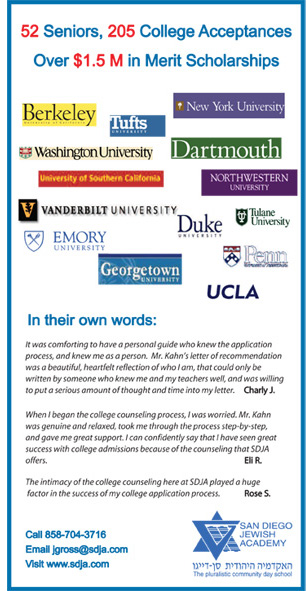

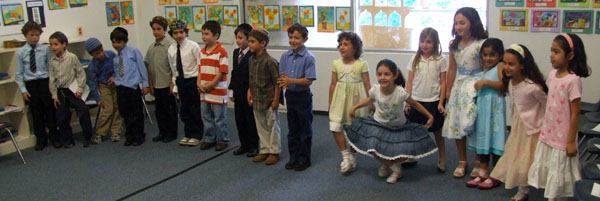
THE JEWISH CITIZEN
Smarter than a 5th grader? I'd have to work myself through 1st grade competion first
By Donald H. Harrison
 SAN DIEGO—Jeff Foxworthy likes to ask television contestants whether they are smarter than a fifth grader. Given how impressive first graders can be, I am afraid to answer. SAN DIEGO—Jeff Foxworthy likes to ask television contestants whether they are smarter than a fifth grader. Given how impressive first graders can be, I am afraid to answer.
At Soille San Diego Hebrew Day School, the first graders in Rebecca McCullough's class know the answers to these questions. See if you do.
Q1: What French painter born in 1839 influenced Impressionist painting to be more solid and flat? Hint: one of his still-life paintings sold for $60 million a decade ago.
Q2: The painter mentioned in Question 1 liked to use different hues of the same color within objects in his paintings. What did he do to help make the objects stand out even more?
Q3: What Russian-born Jewish painter was famous, among other accomplishments, for painting the 12 Tribes of Israel at the Hadassah Hospital in Jerusalem?
Q4: How do the paintings of the artist mentioned in Question 3 differ from those of many other artists?
Okay I won't keep you in suspense. The artist of question 1 is Paul Cezanne, and, per Question 2, he used to outline his objects to make them stand out. Many of my loyal Jewish readers may have guessed that Marc Chagall was the artist mentioned in Question 3. As for how he's different than other artists, his work "is not realistic but more dream-like, with floating animals, angels, flowers, Jewish symbols and circus pictures in many of his pictures."
My source was Jamie, a student is McCullough's class. She is the fifth from the right in the picture above.
Art is one of the subjects taught by McCullough, a University of Colorado graduate who not only is credentialed to work with high-achieving and gifted students like the ones in her class at Hebrew Day School, but also has worked with special-needs students. She is, in other words, a woman of remarkable patience. That is probably how she turned her first graders onto poetry.
Okay, so maybe you know what a couplet is. But how many of you know what kind of a poem a cinquan is? Jacobo, the ninth from the left in the photo, told visiting parents and grandparents during a recent class presentation that a "cinquan in a poem with five lines that don't rhyme. The first line is about one thing. The second line tells two words about it. The third line has three words telling what it can do. The fourth line tells how you feel. The fifth line is the same as the first one."
Perhaps you also know, as Binyamin did, that a haiku is a Japanese three-line poem, wifh five syllables in the first line, seven in the second, and five in the third for a total of 17 beats. And maybe you know, as Shani did, that "an acrostic poem starts by writing a word going down the paper. Then each letter of that word will start a line that tells about the word."
Okay, you smart adults, so what are the mechanics of a one-line poem?
Ezra knew. He told us that it is "made up of two very short sentences. Each sentence has two words. The first word is a noun and the second word is a verb. The verbs need to rhyme."
Lily told us what a "color poem" is. "It does not rhyme," she informed us. "We wrote poems about the color white. We all started the poem with 'White is a snowflake.' And then we wrote eight other things we thought of that are usually white. We ended the poem the same way we started it.
McCullough not only had the students write poems in the styles they later described to us; she also had them copy art works of Cezanne, Chagall, Joan Miro, Claude Monet, and Vincent van Gogh.
At Soille San Diego Hebrew Day School, the academic day is divided into secular and Judaic studies, with half the day devoted to each. The first-grade students also can tell you in great detail about the stories of the Torah.
My grandson Shor, who had studied Chagall in secular class, per Question 3 above, is an enthusiastic Torah scholar. He corrects me all the time. Once I tried to read to him the sentence: "And God said to Moses: go with thy brother Aaron to Egypt and tell Pharaoh to let the people go."
"And God said..."
Ahem, Shor coughed. "It's Hashem."
"Okay," said I. "Hashem said to Moses..."
"Moshe," he said.
"Right," said I. "Hashem said to Moshe, go with thy brother Aaron..
Shor provided the correct Hebrew pronunciation for Aaron.
"...to Egypt..."
"You mean Mitzraim," he said.
And so it went. Nowadays, when I read the portion of the week, I like to check out the columns by Rabbi Baruch Lederman of Congregation Kehillas Torah and Rabbi Leonard Rosenthal of Tifereth Israel Synagogue, both of which usually appear on San Diego Jewish World on Sundays. I also ask Shor what he learned about the portion.
And you know, he really has learned many things I never did!
,


SDJA STUDENT QUARTERLY
SDJA juniors scout prospective colleges
Editor's Note: Over the spring break many San Diego Jewish Academy juniors went to visit colleges and they informally reported their findings to friends. Their reviews provided considerable insight.
By Brenna Decker
University of Redlands: It's only couple hours from San Diego, and I really liked it! I loved the campus. The student store, library and dining hall were all impressive, the food was diverse, plentiful and tasty! Plus they have a neat program where you can basically design your own major, which allows a lot of flexibility
University of the Pacific: Up in Stockton, it has a beautiful campus and looks like an Ivy League school, with ivy-covered brick buildings and columns. However, it felt pretty rigid with the course load, without a lot of flexibility. Also, Stockton used to have pretty high crime rates, but has since worked to improve the city.
On both campuses, bikes were a popular and convenient way to get around. There were bike racks all over. So don't ditch your bicycle; bring it to college with you.
By Michele Goldfarb-Shapiro
UCLA: The campus is gorgeous, the architecture is amazing. The campus is 415 square acres, the smallest of all of the UC campuses. It is located in Westwood, which is in L.A., a big, cute and hip city. The campus is pretty spread out but there are three types of living opportunities, dorms, that are doubles, or triples, suite-style dorms, and apartments. There are 25,000 undergraduates and the first two years you will be in lectures, and then meet with a TA and 20 students twice a week to discuss the lectures. The third and fourth years of college you are in smaller classes with less than 30 students. Compared to SDJA's small classes this seemed slightly impersonal. UCLA has the second highest food rating for all universities: they have a variety of eating options. There is a large Jewish population, and a great Hillel. Only 15% of UCLA participates in Greek life.
Occidental: I loved this school; not only does it have a beautiful campus, but it is so serene. It is located in Eagle Rock, which is in the county of L.A., not in the city. It is 13.2 miles from Beverly Hills, and right near Pasadena, and by downtown L.A. It has lush lawns and pretty buildings, and free parking. There aer some new dorms, and the old ones are currently being renovated. You can design your own major at Oxy, and there are many interesting programs offered. You can travel abroad for a semester, choosing from over 50 countries, and there are other programs such as you do a semester working at the U.N. in New York, which sounds amazing. The school has had a great feel to it; there is a nice sense of community. Most of the students were out and about on campus on a Saturday; they were all super friendly and helpful. Unfortunately, they have a very small Jewish population, but there is a Hillel organization. The professors are very accessible and there is an 11:1 student to teacher ratio.
By Becky Rudin
Pomona College: This college in Claremont, California, wasn't all it was cracked up to be. Gasp! I mean, the people were the friendliest I'd ever met. Happy, happy, happy people. The tour guides were great salesmen. But for some reason, the school didn't feel the way I'd imagined it to be.
Don't get me wrong. I liked Pomona. They have a wonderful "Shakespeare Quad" that has every plant Shakespeare has ever mentioned in his plays besides hemlock, which is poisonous. Squirrels died, people cried, the hemlock was removed. Pretty simple. There was a great Peet's coffee shop, Coop store, and nice dining halls and dorms as well. The only thing I didn't like about the campus itself was that it seemed slightly removed and isolated from the other C's, and the campus was very big, at least for me. The food at Pomona was quite good, yet very fattening. They had salad, fried fish, fried chicken tenders, macaroni and cheese, a bit of steamed broccoli, and ice cream. Pomona is still definitely a contender in my college search, but I don't think I'm in love with it the way I used to be.
Whittier College: The campus layout is a bit weird, and some buildings are a bit run down. Food was terrible, but that could be because they are completely rebuilding the student center and cafeteria and are currently eating in a temporary structure that resembles the nuclear power plant domes at San Onofre. However, there was a great library and student success center. Met up with Xany Leon, a JA grad, and she had lunch with me and my mom and showed us her dorm room which was actually pretty big with lots of closet space, huge window, and space for min-fridge, microwave and food. Whittier was the least attractive of all the schools I visited, but students raved about the accessibility of the teachers and three professors live on campus with their families and bring their pets to school which definitely gave it more of a homey feel. The surrounding area was cute and cozy, but I didn't get the sense that there is much to do on weekends around the college. Also, the students at Whittier seemed a little aloof and some looked like people I wouldn't exactly want to run into on the street.
The preceding story appeared in the June issue of SDJA Student Quarterly, to which San Diego Jewish World editor Donald H. Harrison serves as an advisor


ADVENTURES IN SAN DIEGO JEWISH HISTORY
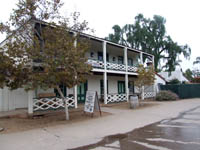
Robinson-Rose House
|
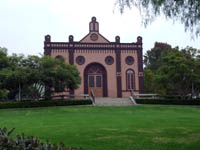
Old Temple Beth Israel |
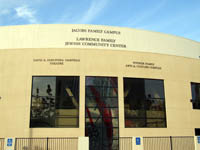
Lawrence Family JCC |
Editor's Note: We are reprinting news articles that appeared in back issues of various San Diego Jewish newspapers. You may access an index of the headlines of those articles by clicking here. You may also use the Google search program on our home page or on the headline index page to search for keywords or names.
Form Community Relations Advisory Committee Here
From San Diego Jewish Press, March 13, 1947, page 3
Eli Levenson has been named chairman of the Community Relations Advisory Committee, which was formed in San Diego recently. Patterned after the National Community Relations Advisory Council, which is comprised of six national organizations: Anti-Defamation League, Jewish War Veterans of the U.S., American Jewish Committee, American Jewish Congress, Union of American Hebrew Congregations and the Jewish Labor Committee, the local group will represent all fations of the local community.
Organized as a civic protective body, the duties of the committee will include anti-defamation work. Rabbi Morton J. Cohn, Dr. A.P. Nasatir, Al Hutler, Nathan F. Baranov, Irving E. Friedman, Louis Steinman, Ben Feinberg, Marshall Roth and Morry Levensen will meet with Mr. Levenson twice a month at lunch to discuss their work.
Crum Demands 100,000 Enter Palestine—Print Mufti Papers
From Southwestern Jewish Press, March 13, 1947, page 3
"If the British government cannot afford to support twenty to thirty thousand troops in Greece, how can they afford to keep over 100,000 troops in Palestine?" Bartley Crum, American member of the Anglo-American inquiry on Palestine, stated when he told convention delegates t the western States regional meeting of the Western States Welfare Funds at the U.S. Grant Hotel Sunday night that the Palestine situation must be faced by the nations of the world today.
Speaking as the convention keynote, Crum, a San Francisco attorney, said: "In Palestine there is the rebirth of belief for which we of the Western World yearn. Three British and three American members of the commission concurred that the White Paper was a violation of the Mandate for Palestine. Further delay in immigration is untenable—even to wait for government action of any kind. To that extent do we dishearten and disillusion the common man of the world."
In a bold statement Mr. Crum accused the powers of the world of still doing business with Fascists by withholding from the public the facts contained in the papers of the Grand Mufti captured by the American army in Germany. "I have seen these papers—1500 of them. They prove that the Grand Mufti was a cold-blooded murder of the Jews and that he instituted the planned execution of thousands of Jewish children and this is the man the British government wants to set up as head of an independent Palestine with a Jewish minority," Crum said. "We are witnessing the downfall, the decay, and crumbling of the British Empire. All that the Jewish people can expect from the Labor Government is delay, evasion and broken promises. We of the West must live up to our obligations to the mandate and demand the immediate entry into Palestine of 100,000 Jewish people. Our State Department has sabotaged every President of the United States and both political parties on this issue. We must decide between oil and blood. We must demand that America act."
Mr. Crum, who minces no words in his talks on his impressions of the Palestine problem, was enthusiastically cheered when he finished his talk.
Other speakers at the same session were Joseph Beck, executive director of the United Service for New Americans, and Robert Herman, director of Field Services of the United Jewish Appeal.
The Western States Conference which started Saturday, March 8, concluded on Monday with delegates from thousands of miles returning to their homes after pledging their wholehearted support to the United Jewish Appeal.
Mr. Herman spoke of the increased needs of European Jews for help from agencies of the United Jewish Appeal this year.
"Several European communities are attempting this year to bear their share of the burden. In France, Jews are organizing a fund raising campaign. Contributions to te Appeal have already been made," he said, "by Hitler's gas chamber victims—$20,000,000 of the 1947 program in 'non-monetary gold,' that is, gold in the form of wedding rings, jewelry and dental work—carefully preserved by Nazi efficiency."
Speaking on the refugee problem, Mr. Beck pointed out that it has only beenthrough the assurance of care by the United Service that Jewish refugees from Hitler Europe have been permitted to enter the United States.
"In spite of the difficulties of adjustment these refugees face," said Mr. Beck, "these newcomers are young and have a tremendous drive to succeed in American life." The most important duties of the United Service for New Americans, according to Beck, is to provide temporary shelter, clothing and nourishment, as well as vocational training, until newcomers have been equipped to take their place in American society.
S.O.S. Passover Needs in Europe
From Southwestern Jewish Press, March 13, 1947, page 4
During the first week in April, Jews the world over will commemorate Passover, the holiday celebrating the historic exodus from Egypt, an ancient land of persecution. In central Europe, the modern land of persecution, Passover will be celebrated at D.P. camps.
There is no better time than this holiday, when we recall our forefathers' wanderings in the wilderness, to remember the Jews across the sea. There is no better time to contribute to their welfare. For supplies to reach Europe in time for Passover, collection of food and clothing must begin now. There is a need for canned Gefulte fish, marked as approved "For Passover," matzoh meal, dried fruits of all kinds, nuts in shells, salt and pepper, among other items.
Bring these supplies, plus clean, warm clothing, plus regular canned items of food to: Douglas Tire Co., 11th and Market Sts. If you cannot deliver your contributions, call F-0171 and someone will call at your home.
Remember... in preparing your own Passover, think of these very needy European Jews. They have only you to turn to.
{Return to top}

Nancy Harrison
cruise & tour specialist
(619) 265-0808

SAN DIEGO JEWISH WORLD THE WEEK IN REVIEW
Arts & Leisure
The emperor is even worse than naked by Sheila Orysiek in San Diego
Frieda's big surprise at Frida's Restaurant by Donald H. Harrison in Chula Vista, California
Play tackles nature of American Judaism by Cynthia Citron in Los Angeles
San Diego County
Three articles from SDJA Student Quarterly, a student publication of San Diego Jewish Academy:
—Across the Editor's Desk by Alexa Katz
—SDJA 'Spring Fling' went under water by Michelle Rizzi
—Fellowship to Jack deTar by Gaby Maio
Adventures in San Diego Jewish HistoryMiddle East
Hamas acknowledges its responsibility for rocket attacks that killed 26 Israelis by Ira Sharkansky in Jerusalem
To the Israeli government: Do something! by Yankele Cohen in Kibbutz Nahal Oz, Israel
Judaism
Continual study: too much of a good thing? by Rabbi Leonard Rosenthal in San Diego
Trusting in Hashem at Bear Stearns by Robert Savit via Rabbi Baruch Lederman in San Diego
San Diego County
Green collective for Jewish institutions? by Marissa Palin in San Diego
Three articles from SDJA Student Quarterly, a student publication of San Diego Jewish Academy:
—Seniors leave big shoes for juniors to fill by Gaby Maio
—Pickets target SDJA by Eitan Frysh
—New programs in SDJA ASBC by Shiri Bogomolny
Arts & Leisure
The Schwartzes within The Brady Bunch by Cynthia Citron in Hollywood, California
Sports theme at San Diego County Fair by Donald H. Harrison in Del Mar, California
Adventures in San Diego Jewish History
—March 6, 1947: Western States Meet; Here This Weekend
—March 6, 1947: Beth Jacob to Have New Rabbi
—March 27, 1947: Wins Akiba Award
Middle East
Weighing Obama and McCain from an Israeli perspective, each has drawbacks by Ira Sharkansky in Jerusalem
UK academic boycott of Israel resurfaces by Lloyd Levy in London
Canada
New Yorker brings California-style Jewish healing service to Anglophone Toronto by Rabbi Dow Marmur in Toronto
San Diego
Three commentaries from SDJA Student Quarterly, a student publication of San Diego Jewish Academy:
—Taking the SAT: The best four hours I ever spent trying to gouge out my eyes with a pen by Micah Frank
—CA court advances march to equality by Harry Doshay
—Iran's deadly bias against gays by Sarah Abelsohn
The Arts
Chapter Eleven of Reluctant Martyr, a serialized novel by Sheila Orysiek of San Diego
When octogenarian father and 40ish son both are single, who gives dating advice? Book review by Donald H. Harrison in San Diego
Programme Request? Take A Number by Carol Davis in San Diego
Adventures in San Diego Jewish History
—March 27, 1947: U.J.F. Off To Flying Start: San Diego Aware of Unprecedented Need in 1947—Geared to Meet It
—March 27, 1947: Editorial Page: Hope, Faith and Charity
—March 27, 1947: We were there by Albert Hutler
Middle East
The presumptive presidential candidates address the American Israel Public Affairs Committee on Israel and the Middle East:
—Barack Obama to AIPAC, June 4
—John McCain to AIPAC, June 2
—Clinton: Obama a good friend to Israel
Was that Condy Rice... or Sandy Berger? by Shoshana Bryen in Washington, D.C.
San Diego
Guardians' golf and tennis tournament a fitting Seacrest fitness-center fundraiser by Donald H. Harrison in Rancho Santa Fe, California
The Arts
Thursdays With The Songs of Hal Wingard
—Purely White
—Purely Black
—Together
Insiders File
—The people behind San Diego Jewish World
Adventures in San Diego Jewish History
—Palestine Capable of Absorbing 1,100,000 Says Nathan
—Palestinian To Speak Here on Tuesday
—We Were There by Albert Hutler
)
Middle East
Condoleezza Rice's stand over Gaza scholarships is counterproductive by Shoshana Bryen in Washington, D.C.
United States of America
Elections, conversions, award ceremonies: the shehecheyanu moments of springtime by Donald H. Harrison in San Diego
Lifestyles
Women are the subject of our local Jewish trivia quiz by Evelyn Kooperman
Adventures in San Diego Jewish History
—January 9, 1947: Kaufmans Feted On Departure
—January 9, 1947: Jewish Labor Committee by Ben Feinberg
—January 9, 1947: Pioneer Women's Organization
Middle East
Israel, at 60, has many kvelling points by Dorothea Shefer-Vanson in Mevasseret Zion, Israel
Syria's 10-meter problem at the Kinneret by J. Zel Lurie in Delray Beach, Florida
The Arts
Masterful retelling of Shoah in Vilna by Donald H. Harrison in San Diego
From Red Diaper Baby to Citizen Josh by Carol Davis in San Diego
Lifestyles
Are you lazy? You can put the blame on your genes—when you get around to it by Natasha Josefowitz in La Jolla
Adventures in San Diego Jewish History
—December 16, 1946: That's What I Think by Ray Solomon
—December 16, 1946: J.C.S.C. by Joe Wertheim
—January 9, 1947: Robt. R. Nathan-Wollheim To Speak Here Monday
Link to previous editions
< BACK TO TOP
|
|
